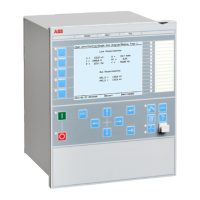K
3
I
FA
I
A
Z
L
×
----------------
Z
A
Z
B
+
Z
1
Z
A DD
+
---------------------------
1+
è ø
æ ö
×=
EQUATION106 V1 EN (Equation 68)
and:
• Z
ADD
= Z
A
+ Z
B
for parallel lines.
• I
A
, I
FA
and V
A
are given in the above table.
• K
N
is calculated automatically according to equation 64.
• Z
A
, Z
B
, Z
L
, Z
0L
and Z
0M
are setting parameters.
For a single line, Z
0M
= 0 and Z
ADD
= 0. Thus, equation 65 applies to both single and
parallel lines.
Equation 65 can be divided into real and imaginary parts:
p
2
p Re K
1
( ) Re K
2
( ) R
F
Re K
3
( ) 0=×–+×–
EQUATION107 V1 EN (Equation 69)
p Im K
1
( ) Im K
2
( ) R
F
Im K
3
( ) 0=× ×–×+× ×–
EQUATION108 V1 EN (Equation 70)
If the imaginary part of K
3
is not zero, R
F
can be solved according to equation 70, and
then inserted to equation
69. According to equation 69, the relative distance to the fault
is solved as the root of a quadratic equation.
Equation 69 gives two different values for the relative distance to the fault as a
solution. A simplified load compensated algorithm, which gives an unequivocal figure
for the relative distance to the fault, is used to establish the value that should be selected.
If the load compensated algorithms according to the above do not give a reliable
solution, a less accurate, non-compensated impedance model is used to calculate the
relative distance to the fault.
12.13.7.3 The non-compensated impedance model
In the non-compensated impedance model, I
A
line current is used instead of I
FA
fault
current:
1MRK 505 277-UUS C Section 12
Monitoring
307
Technical Manual

